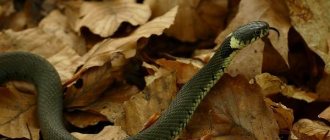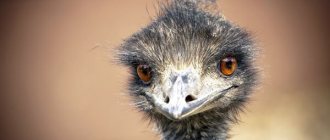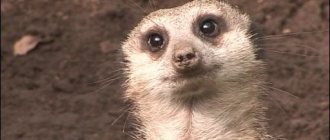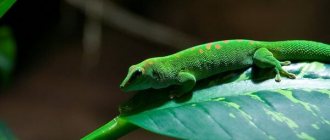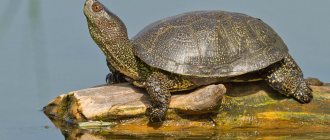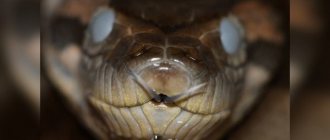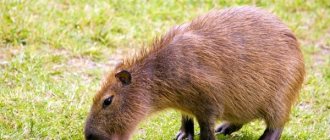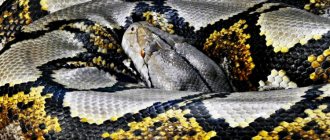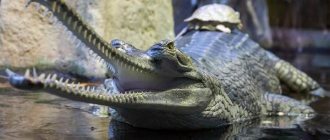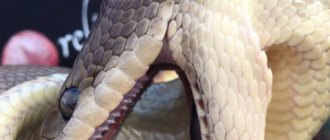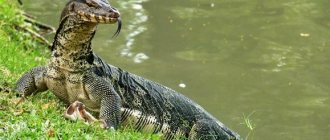9013
9014
9015
male 10920
male and female 10921
male and female 10922
female 10923
female 10924
female 10925
11365
11366
Description of the tutelage
At first glance, it is quite possible to confuse the tuatteria with an ordinary, fairly large-sized lizard . But there are a number of characteristics that make it possible to easily distinguish representatives of these two species of reptiles. The body weight of adult male tuateria is about a kilogram, and sexually mature females weigh almost half as much.
Appearance
The animal, similar in appearance to an iguana, belongs to the genus Sphenodon, has a body with a length of 65-75 cm, including the tail. The reptile is characterized by olive-green or greenish-gray coloring on the sides of the body. On the limbs there are pronounced, yellowish spots that vary in size.
Just like the iguana, along the entire surface of the tuatteria’s back, from the occipital region to the tail, there is a not too high crest, which is represented by characteristic, triangular-shaped plates. It is thanks to this crest that the reptile received another very original name - tuatara, which translated means “spiny”.
However, despite the external resemblance to a lizard, around the end of the second half of the nineteenth century, this reptile was assigned to the beak-headed order (Phynchocerphalia), which is due to the structural features of the body, in particular the head region.
A distinctive feature of the structure of the hatteria's cranium is an interesting feature, represented in the youngest individuals by an unusual upper jaw, roof of the skull and palate, which have pronounced mobility relative to the brain case.
This is interesting! In fairness, it should be noted that the presence of cranial kineticism is inherent not only in such a reptile as the hatteria, but is also characteristic of some species of snakes and lizards.
This unusual structure in hatterias was called cranial kineticism . The result of this feature is the ability of the anterior end of the animal's upper jaw to bend slightly downward and retract back in conditions of quite complex movements in the area of other parts of the cranium of a rare reptile. The feature was inherited by terrestrial vertebrates from lobe-finned fish, which is a proven and very distant ancestor of the hatteria.
In addition to the original internal structure of the cranium and skeletal part, the presence of a very unusual organ in the reptile, represented by the parietal or third eye, located in the back of the head, deserves special attention from domestic and foreign zoologists. The third eye is most pronounced in the youngest immature individuals. The appearance of the parietal eye resembles a bare spot surrounded by scales.
Such an organ is distinguished by light-sensitive cells and a lens, with a complete absence of muscles that are responsible for focusing the location of the eye. As the reptile gradually matures, the parietal eye becomes overgrown, so in adult specimens it is difficult to distinguish.
Lifestyle and character
The reptile is active only in low temperature conditions, and the optimal body temperature of the animal is within 20-23°C. During the daytime, the tuateria always hides in relatively deep burrows, but with the onset of evening coolness it comes out to hunt.
The reptile is not very mobile. The hatteria is one of the few reptiles that have a real voice, and this animal's sad and hoarse cries can be heard on foggy nights.
This is interesting! The behavioral characteristics of the tuateria also include cohabitation on island territories with the gray petrel and the mass colonization of bird nests.
During the winter, the animal hibernates. A tuateria grabbed by the tail quickly throws it away, which often allows the reptile to save its life when attacked by natural enemies. The process of regrowth of a discarded tail takes a long time.
Characteristic is the ability of representatives of the Beak-headed order and the Wedge-toothed family to swim very well and also hold their breath for an hour.
Lifespan
One of the biological features of such a reptile as the tuateria is a slow metabolism and inhibited life processes, which causes the animal to not grow and develop too quickly.
The tuateria becomes sexually mature only at the age of fifteen or twenty years, and the total life expectancy of the reptile in natural conditions may well be one hundred years. Individuals raised in captivity typically live no more than five decades.
Return to content
Features of hutteria
Cold-blooded and slow-moving, ancient tuataria are a kind of chubby-cheeked, long-tailed iguana, with spines on their neck, back and tail, as long as a human forearm. Their name translated from the Maori language means “spikes on the back.”
Lizard Hatteria (Tuatara)
The tuatara has one row of teeth on the lower jaw and two rows on the upper jaw. The upper jaw is rigidly attached to the skull. Their teeth are an extension of the jaw bones. When they wear out, they are not replaced, but they also do not fall out. This distinctive and unique feature influences the mechanism of food absorption.
Newborn individuals have a horny, non-calcified, so-called egg tooth, which is provided by nature to facilitate emergence from the egg. Soon after birth, this tooth falls out. Unlike lizards, the vertebrae of the hatteria are more reminiscent of the vertebral bones of fish and some other amphibians. Their bony ribs are more typical of crocodiles than lizards. Males do not have a sexual organ. Tuatara is one of the least studied and most ancient animals.
Lizard Hatteria (Tuatara)
Hatterias reach their peak activity when their body temperature is 12-17 degrees Celsius. This is a record among reptiles for the minimum temperature suitable for life. Perhaps this is the reason why the species was able to survive in the temperate climate of New Zealand. Other reptiles are active when their body temperature is between 25 and 38 degrees Celsius. Another remarkable feature of tuataras is their breathing rate. They breathe air only once an hour. The species does not need to drink water.
Range and habitats
The natural habitat of the tuatteria until the fourteenth century was represented by the South Island, but the arrival of the Maori people caused the complete and fairly rapid disappearance of the population. On the territory of the North Island, the last specimens of the reptile were seen at the beginning of the twentieth century.
Today, the habitat of the most ancient reptile, the New Zealand tuataria, is exclusively small islands near New Zealand. The habitat for the tuateria was specially cleared of wild predatory animals.
Return to content
Nutrition of the tuateria
Wild tuataria has an excellent appetite . The diet of such a reptile animal is very diverse and is represented by insects and worms, spiders, snails and frogs, small mice and lizards.
Quite often, hungry representatives of the ancient order of Beak-headed and the Wedge-toothed family destroy bird nests, eat eggs and newborn chicks, and also catch small birds. The caught victim is swallowed almost completely by the hatteria, after being only lightly chewed with very well-developed teeth.
Return to content
Lifestyle
Hatterias live on rocky coastal islands with a harsh climate. These unusual animals have established almost friendly relations with petrels. They live in holes dug by these birds.
With the onset of darkness, when the petrel returns home, the hatteria leaves the hole, as it leads a nocturnal lifestyle. In the morning, when the petrel flies away in search of food, the lizard returns to the hole, which it thus shares with the huge bird.
Hatteria remains active even if the outside temperature drops below 70C.
Hatteria feeds on arthropods, worms, snails and other invertebrates, occasionally eating the eggs and chicks of small birds, as well as frogs, small lizards and large insects.
This lizard is under strict state protection, due to which the population has recently increased significantly.
Hatterias may not breathe for up to an hour. Hatterias are exceptionally slow creatures. Even between inhalations and exhalations they take at least 7 seconds.
Reproduction and offspring
In the midst of the summer period, which comes to the territory of the Southern Hemisphere approximately in the last ten days of January, the process of active reproduction begins in an unusual reptile belonging to the ancient order of Beak-headed and the Wedge-toothed family.
After fertilization occurs, the female lays from eight to fifteen eggs nine or ten months later . The eggs laid in small holes are buried with earth and stones, after which they are incubated. The incubation period is very long, about fifteen months, which is absolutely unusual for other types of reptiles.
This is interesting! The optimal temperature level, which allows approximately equal numbers of tuateria babies of both sexes to be born, is 21°C.
Scientists from one of the leading Universities of Wellington conducted very interesting and unusual experiments, during which they were able to establish a direct relationship between temperature indicators and the sex of the hatched offspring of the tuataria. If the incubation process occurs at a temperature of plus 18°C, then only females are born, and at a temperature of 22°C, only males of this rare reptile will be born.
Return to content
Natural enemies
Hatterias are the only host for any stages of development of such a parasitic mite as Amblyomma sphenodonti Dumbleton. More recently, the natural or natural enemies of reptiles from the order Beak-headed and the Wedge-toothed family were represented by wild animals, dogs and rats, which inhabited the island territory in abundance and contributed to a sharp reduction in the overall number of tuateria. Wild predators feasted with great pleasure on the eggs and young of rare reptiles, which was a direct threat to the survival of the tuataria.
This is interesting! Due to the very low rates of metabolic processes, the reptile tuatara, or the so-called tuatara, has a very interesting feature - it is able to breathe with a difference of seven seconds.
Currently, the process of settling islands inhabited by “living fossils” is controlled as carefully as possible by the people themselves. To ensure that the population of the three-eyed lizard is not threatened, the number of all species of predators inhabiting the territory is strictly controlled.
Anyone wishing to see an unusual-looking tuataria in its natural habitat must obtain a special permit or a so-called pass. Nowadays, Hatteria or tuatara is listed on the pages of the International Red Book, and the total number of all existing reptiles is about one hundred thousand individuals.
Return to content
Population and species status
Such an unusual and quite rare “living fossil”, a significant part of the representatives of which existed on our Earth about two hundred million years ago, is currently found only in the rocky or island territories of the straits. That is why this unique and rare reptile these days is incredibly strictly protected.
This is interesting! Despite the fact that the reptile is very similar in appearance to a fairly large iguana, the structure of the internal organs of the tuateria is more similar to representatives of fish, snakes or crocodiles.
The total number of all currently living tuataria is about one hundred thousand individuals. The largest colony is located on the Stephens Island territory near Cook Strait, where about 50 thousand tuatara live. In small areas, the total population of tuataria, as a rule, is no more than five thousand individuals.
The New Zealand government has long been aware of the value of such an amazing and rare reptile, and therefore has introduced a very strict and controlled conservation regime. Tuatara are currently being successfully bred at the Sydney Zoo in Australia.
It should be noted that tuateria are inedible, and the skin of such an animal has no commercial demand, which contributes to a certain conservation of the population . Of course, nothing threatens the survival of such unique reptiles today, and in captivity, this representative of the ancient order of beaked heads and the Wedge-toothed family is kept only in a few zoological parks.
Among other things, until 1989 it was generally accepted that there was only one species of such reptiles, but the famous professor at Victoria or Wellington University, Charles Dougherty, managed to prove from a scientific point of view that today there are two common species - the hatteria (Sphenodon punstatus) and Tuatara from the island territory of Brother.
Return to content
Interesting Facts
- Although the reptile externally resembles a large iguana, the hatteria and its internal structure of organs are more similar to fish, snakes or crocodiles.
- At birth, a baby tuateria has a third eye on the crown of its head, which is completely covered by scales by 4-6 months.
- She can remain alive without taking a single breath for 60 minutes.
- Hatteria or tuatara is the only representative of antiquity that managed to preserve its original appearance to this day.
